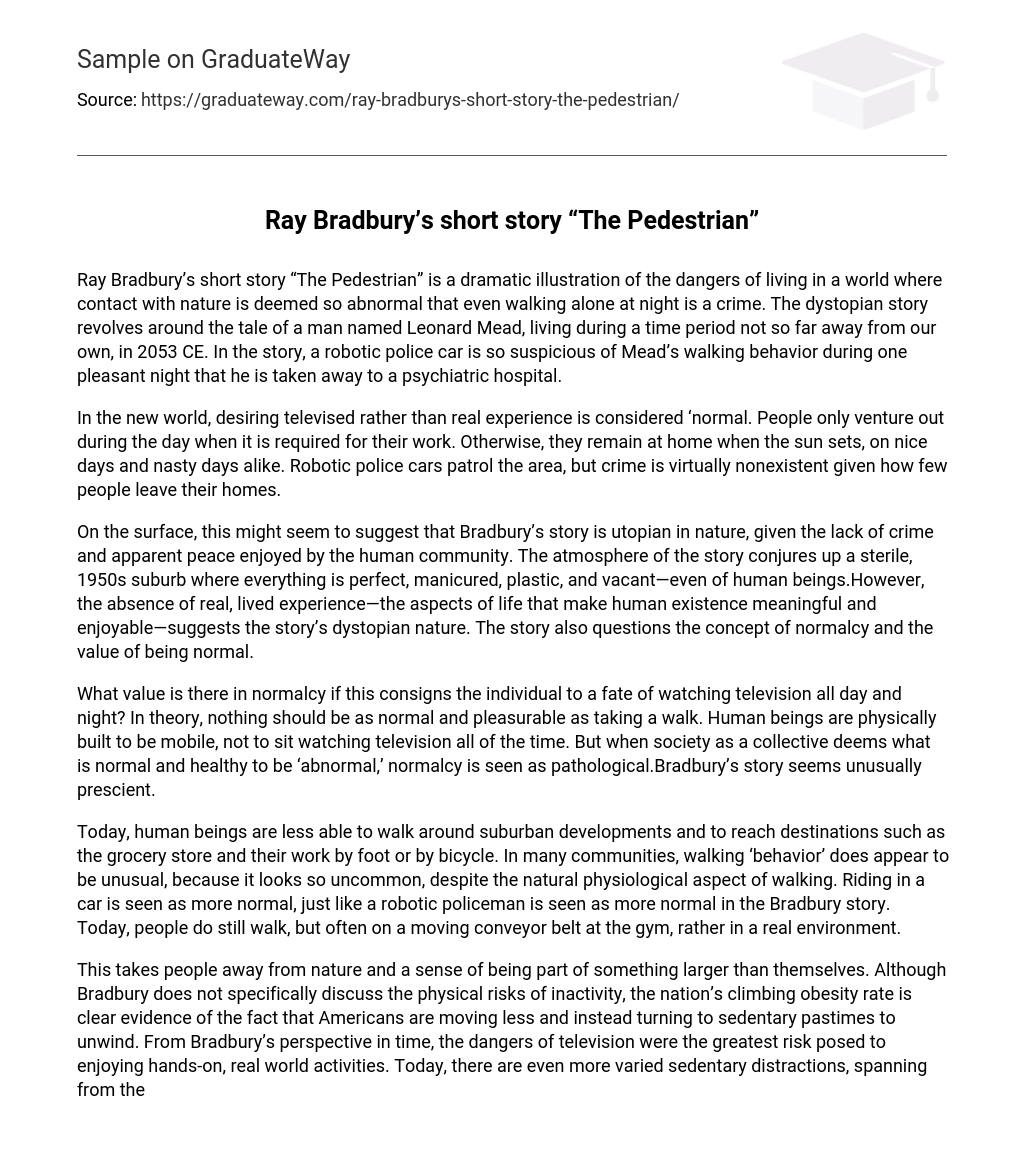In Ray Bradbury’s “The Pedestrian,” the dangers of residing in a society where simply walking alone at night is deemed criminal due to its deviation from human interaction with the natural world are explored. The narrative takes place in 2053 CE and centers around Leonard Mead, who experiences the repercussions of his leisurely stroll that raises suspicion in an automated police vehicle, ultimately resulting in his institutionalization at a mental health facility.
In this futuristic world, it is socially acceptable to prioritize television viewing over real-life experiences. People only venture outdoors during the day for work-related reasons and prefer staying indoors regardless of weather conditions after sunset. Robotic police cars surveil the area, resulting in a scarcity of crime as few individuals dare to step outside.
The text initially suggests that Bradbury’s story contains utopian elements, as it depicts a crime-free community that appears to be peaceful. The story’s setting establishes an image of an idealized 1950s suburb that is meticulously maintained but lacks any human presence. However, the absence of authentic lived experiences, which provide purpose and happiness in human existence, implies a dystopian aspect to the narrative. Additionally, the text also challenges conventional ideas of normality and raises doubts about the value of conforming to societal expectations.
Why is it important to value normalcy, even if it entails spending the entire day and night watching television? The concept suggests that there is nothing more typical and pleasurable than taking a walk. Our nature as humans is to be active, rather than constantly sitting in front of the television. Nevertheless, when society collectively determines that what is deemed normal and healthy is actually “abnormal,” normalcy starts being perceived as an issue. Bradbury’s story seems to remarkably anticipate this phenomenon.
Today, there is a decrease in the ability of individuals to navigate suburban areas on foot or by bike in order to reach destinations like the grocery store or workplace. This lack of pedestrian activity is noticeable in many communities and stands out due to the rarity of seeing people walk, despite walking being a natural physical activity. On the other hand, driving a car is perceived as more typical, resembling the acceptance of a robotic policeman in Bradbury’s story. Although people still engage in walking, it commonly occurs on a treadmill at the gym rather than in an actual outdoor setting.
Despite not mentioning the physical hazards of inactivity, Bradbury’s viewpoint entails that individuals are detached from nature and a feeling of belonging to something greater than themselves. This notion is substantiated by the nation’s climbing obesity rate, which serves as clear proof that Americans are engaging in less physical activity and instead opting for inactive pastimes to relax. During Bradbury’s era, television was considered the largest threat to participating in hands-on, real-life experiences. Today, there exist an array of sedentary diversions, ranging from the Internet and mobile phones to video games.
Our reliance on technology devices, such as cellphones, cars, and computers, is progressively shaping who we are. Instead of our physical presence, these devices now define our identities. Consequently, our capacity to entertain ourselves without technological aid has dwindled. However, it is crucial to recognize that our connection to nature in its purest form, devoid of technology’s influence, is what truly forms our individuality. The shows we watch on television or the aesthetics of our cellphones do not hold the same significance.
Bradbury’s cautionary tale serves as a clear indication that we are not paying attention to the warning. Despite the abundance of technological distractions, this only further confirms that our current reality aligns with a dystopian, rather than a utopian, world as presented by Bradbury.





